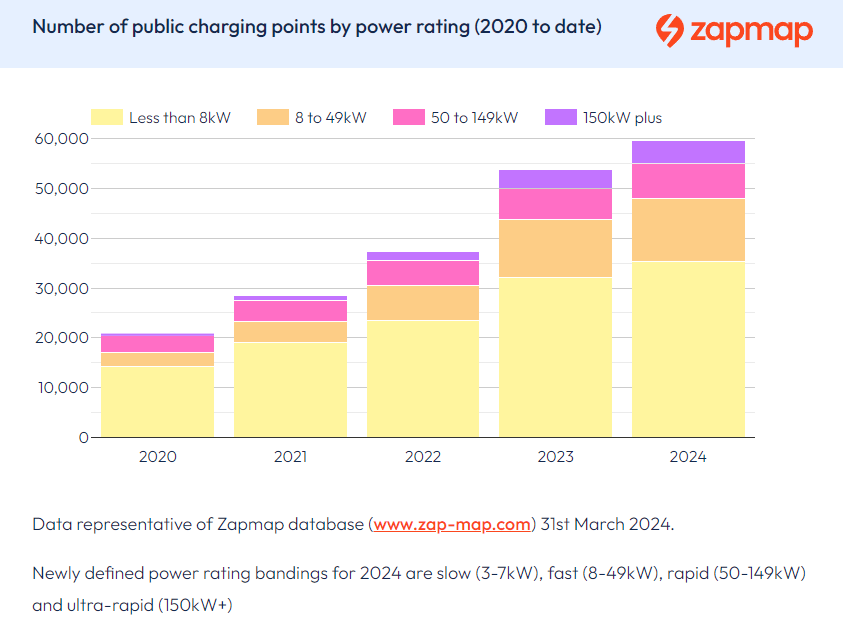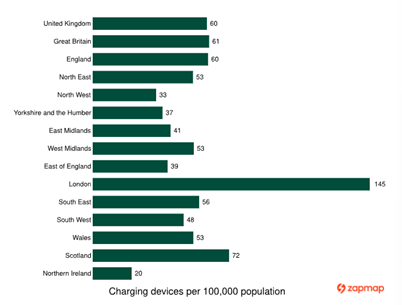
Where Can I Charge My Electric Car? (UK)
Find out where you can charge your electric car in the UK
You can charge an electric car at home or at a range of public charging points. As of January 2024, there are over 55,300 public charging devices at more than 31,000 UK locations. That means that you can travel almost anywhere in the country and still have the ability to recharge your electric car when needed.
But how do you find out where you can charge your electric car, especially when you’re away from home on a business trip or holiday?
Where Can I Charge My Electric Car?
You can charge most electric cars at any of the four types of UK charging points: Slow (3-5kW), Fast (7-22kW), Rapid (25-99kW) and Ultra-Rapid (100kW+).
The only exceptions are the Smart fortwo and Smart forfour which aren’t compatible with Rapid and Ultra-Rapid charging points - some older electric car models are not compatible with rapid charging points either.
The most common home charging points are 3.6kW and 7kW chargers, while the most common public charging points are 22kW and 50kW.
If you own a Tesla, you can also charge your car on the Tesla Supercharger Network (up to 150kWh). Most Tesla drivers receive a set amount of free kWh a year.
So, where can you find your nearest public charging point?
Where is My Nearest Public Charging Point?
You can find public charging points in a range of UK locations. These include:
-
Workplaces
-
Motorway Service Stations
-
Supermarket Car Parks
However, you won’t yet find public charging stations at every car park. What’s more, if you’re low on charge and away from home, the last thing you want to do is try every supermarket car park, hoping that one of them has a public charging point available. This means you need to know where to look in advance.
Fortunately, it’s easier than ever to find out where you can charge your electric car.
How Do I Find Public Charging Points Near Me?
The easiest way to find nearby public charging points is by using a free mobile app. The current market leader is Zap-Map. This offers a nationwide map of UK charging points as well as easy in-app payment for charging (Zap-Pay).
It even includes the location of fast-charging points in the route planner as well as real-time updates about which charging points are occupied, broken or free. This means you'll always have the confidence of getting where you want to go, even on long journeys.
Other free apps include:
-
PlugShare
-
Chargemap
-
Charge Point
-
Pod-Point
You can also search on Google Maps for EV chargers and add them to your journey when using the directions tool.
Make sure you download and register with at least one of these apps before taking your electric car away from home. That way, you won't have to worry about running out of charge, even in a town or city you don't know well.
How Much Does it Cost to Charge My Electric Car in Public?
According to Zapmap, the weighted average price to charge an EV on the public charging network in January 2024 was 56p/kWh for slow/fast chargers, and 80p/kWh for rapid/ultra rapid chargers.
This works out as 17p and 24p per mile, respectively.
Bear in mind that some chargers will cost more than this depending on the brand and where they are. Some supermarkets also provide free charging.
How is the UK Charging Points Network Growing Over Time?
The past few years have seen an increase in public chargers.
The chart from Zapmap below reveals the number of public charging point by power rating from 2020 to date. You can find the interactive version on Zapmap’s site.

Where are the Majority of Charging Devices?
According to a report by gov.uk, in partnership with Zapmap, there is an uneven geographical distribution of charging stations in the UK.
The chart below shows the number of public charging devices per 100,000 of population, according to the region.
London clearly takes the lead, with 145 chargers per 100,000 people, followed by Scotland, which has 72 chargers per 100,000.
Northern Ireland comes in last place, with just 20 chargers per 100,000 people.

All data courtesy of Zapmap and GOV.UK in partnership with Zapmap.
Please find the full Zapmap source here, and the GOV.UK source here.
Read More
How Can I Charge an Electric Car at Home With No Driveway?
Charging an electric car at home sounds great, but what if you don’t have a driveway? Is it still possible to charge an electric car at your house? Find out all you need to know on the topic here.
What Electric Cars are Currently Available?
There are over 20 car manufacturers who currently make electric cars, and over 50 all-electric models are available in the UK. Find out more in this article, which details who makes EVs as well as which models are currently available.
How Much Does it Cost to Install an Electric Car Charger?
If you want to experience the convenience and lower cost of charging an electric car at home, you must first install the right type of charger. Find out more in this article, which details how you can install yours as well as how much it costs to install one at your house.
Here's Why Electric Cars Can't Charge Themselves
Finding somewhere to charge your electric car can be stressful, especially if you're out and about. Unfortunately, a self-charging EV isn't possible at the minute because the technology and infrastructure don't exist to support it. Learn more about why electric cars can't charge themselves in this guide.
3 Things You Need to Know About a Portable Electric Car Charger
If you're often caught short looking for public charging points, a portable charger might give you the extra burst of energy you need. We discuss some of the biggest electric car charger companies and the portable chargers they sell in this handy article.